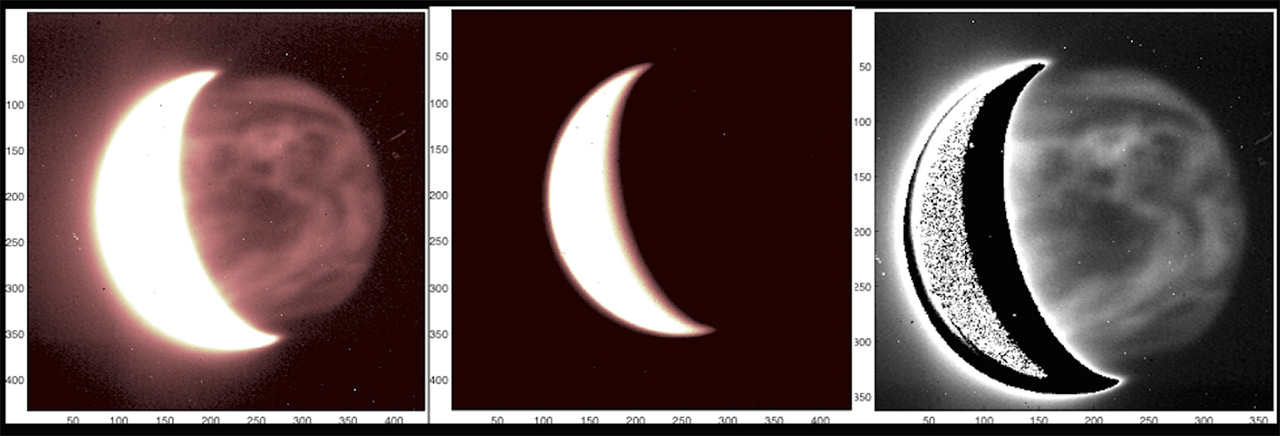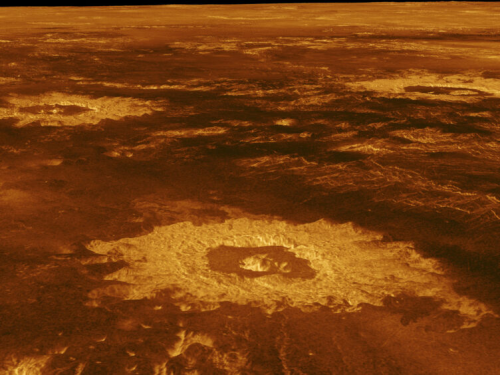The secret of Venus may be hidden in the heat of the night
Despite being close to Earth and having nearly the same size, Venus is another world. Underneath its thick mantle of acid sulfuric clouds, at the surface 460 degrees Celsius are the rule. This temperature is kept by the greenhouse effect of a virtually carbon dioxide only atmosphere. Seventy kilometres above, one has to withstand a perpetual storm-like wind, the product of the so called Venus superrotation. The Near Infrared Camera Spectrometer (NICS) installed at the Telescopio Nazionale Galileo contributes to obtain the most complete profile of Venus’ winds parallel to the equator (zonal wind) and at the altitude of the bottom of the cloud deck.
Images recovering the nightside from pole to pole were captured between 11 and 13 July, 2012. On those same days and in a coordinated strategy, the Venus Express ESA-probe observed in ultraviolet light the top of the clouds, about 20 kilometres above, at 70 km of altitude from Venus’ surface. One of the novel results was the concurrent measurement of the speed of the wind at two different heights 20 km apart. The team lead by Pedro Machado registered a difference in wind speed of about 150 km/h, being faster at the top of the clouds. This result gives important clues about how energy is being transferred from the heat of the lower layers to feed the superrotation of the atmosphere.
It appears that winds accelerate as we move upward to increasing altitudes. The temperature at the ground level reaches 460 degrees Celsius and produces infrared radiation which heats the air and makes it move up. This radiation passes through the most transparent regions of the bottom of the clouds, at roughly 48 kilometres above the surface. When Venus is observed in infrared, we see this light radiate from the heat of the surface, and the silhouettes of the clouds, opaque and dark, become visible.
Observing and following the clouds at one-hour intervals, and using a tracking technique the researchers indirectly computed the speed of the wind pushing those clouds. This speed is around 216 km/h at the bottom of the cloud deck and at medium latitudes, decreasing to half closer to the poles. Also tracking these clouds, speeds of the order of 360 km/h were obtained. Other studies and computer simulations indicate that the speed of the wind at the bottom of the clouds is nearly constant, without significant differences between day and night. The team was then able to assume that the wind speed registered at night is the same at the lower layers of the atmosphere on the dayside.
This study also demonstrates that the observations conducted from Earth complement the data being collected at the same time by space missions. Despite the lower spatial resolution, due to the distance our planet is from Venus, it is in general possible to have a global view of our neighbour, which space probes, due to their orbits, are not always able to get.
This work was undertaken by a team led by Pedro Machado, Instituto de Astrofísica e Ciências do Espaço (Lisbon). Link at the paper: https://www.mdpi.com/2073-4433/13/2/337.Images and audio (in Portuguese) available at: https://cirrus.ciencias.ulisboa.pt/owncloud/s/GFb2PgWSc8e9WoP

Venus seen in the near infrared with NICS installed at the TNG. This sequence demonstrates the process of subtracting the brightness of the dayside of Venus, so that the details of the nightside can be analysed. The dark areas on the right side of the first and third image are clouds, while the bright areas are less opaque regions through which escapes the thermal (infrared) radiation from the surface of the planet. Image obtained on July 11, 2012. Credits: Pedro Machado, et al. 2022

Surface of Venus, observed by Magellan probe, of NASA, which mapped the whole surface of the planet using a radar in the early 1990s. Evidence of volcanic activity and impact craters can be seen. Credits: NASA/JPL

